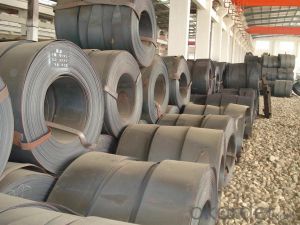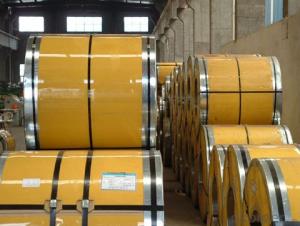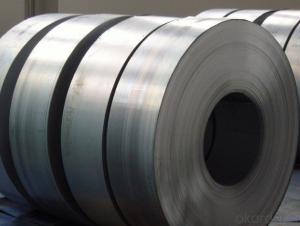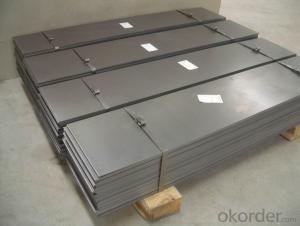Steel Coil In Slip Good Quality Hot Rolled
- Loading Port:
- Tianjin
- Payment Terms:
- TT OR LC
- Min Order Qty:
- 500 m.t.
- Supply Capability:
- 3000 m.t./month
OKorder Service Pledge
OKorder Financial Service
You Might Also Like
Item specifice
1. Product Description
Narrow strip steel is below 650 mm steel, the product in a bar or roll supplies.Due to the edges of the strip shape after rolling strip steel is more suitable for welding after the slitting, so much for welded pipe, metal construction and daily necessities such as blank.With method of continuous production of narrow strip steel by using many sets of vertical roll mill and obtain good shape of edge, the edge shearing defects such as flash and burr, thus ensuring welding performance.It than with wide strip slitting machine cut into strip saves a vast amount of equipment, so it is more suitable for simple equipment of small and medium-sized enterprises.
2. Main Features
Hot rolled narrow strip in the old open-train mill in the production process of flat steel production process is similar in general section mill;In the new continuous mill production, its technological process and equipment structure form basically similar with wide strip production technology for HSM.Hot rolled narrow strip steel billet for slab and billet used in the production of two.From increasing production capacity and simplify the production process, the slab is good, but must be sufficiently workshop or add big mill to provide.When using billet as blank, although production was lower, but the source is more easily, for small and medium-sized enterprises, have simplified equipment and the advantages of independent production.The main factors influencing the quality of hot rolled narrow strip steel product with billet defects, rolling temperature, rolling tension and roll wear and surface roughness, etc
3. Excellent Product Image

4. Application
The classification of strip steel by the material divided into two categories, ordinary steel strip and high quality steel strip;According to the processing method is divided into hot and cold rolling.The purpose of strip steel is widely used in production of welded steel pipe, cold bending steel billet, manufacturing bicycle frame and wheels
5. FAQ
1.Q: Do you have attended any exhibition?
A: We almost go to Canton Fair and Overseas Exhibitions every year.
2. Q: How to guarantee the quality of the products?
A: We have established the international advanced quality management system,every link from raw material to final product we have strict quality test;We resolutely put an end to unqualified products flowing into the market. At the same time, we will provide necessary follow-up service assurance.
3. Q: How long can we receive the product after purchase?
A: Usually within thirty working days after receiving buyer’s advance payment or LC. We will arrange the factory manufacturing as soon as possible. The cargo readiness usually takes 15-25 days, but the shipment will depend on the vessel situation.
Why choose us?
Pre-sale Service
1. Sample can be offered with sample charge and courier fee by buyer's side.
2. We have full stock,and can deliver within short time.Many styles for your choices.
3. OEM and ODM order are accepted, Any kind of logo printing or design are available.
4. Good Quality + Factory Price + Quick Response + Reliable Service, is what we are trying best to offer you
5. All of our products are produce by our professional workman and we have our high-work-effect foreign trust-worthy sales team.
6. We have 18 years' experience of design, manufacture and sell lingerie, we cherish every order from our honor.
After you choose
1. Count the most efficient shipping cost and make invoice to you at once.
2. Check quality again, then send out to you at 1-2 working day after your payment.
3. Email you the tracking no, and help to chase the parcels until it arrive you.
- Q:What are the common tensile strengths for steel strips?
- The common tensile strengths for steel strips can vary depending on the specific grade and type of steel being used. However, generally speaking, the tensile strengths for steel strips typically range from 300 to 2,500 megapascals (MPa). For instance, low carbon steel strips typically have tensile strengths in the range of 300 to 600 MPa, while high carbon steel strips can have tensile strengths ranging from 1,200 to 2,500 MPa. Furthermore, stainless steel strips, which are known for their corrosion resistance and strength, generally have tensile strengths ranging from 600 to 1,500 MPa, depending on the specific grade and composition. It is important to note that these ranges are approximate and can vary based on factors such as the manufacturing process, heat treatment, and alloy composition. Therefore, it is always recommended to consult the manufacturer's specifications or standards for accurate tensile strength values for specific steel strips.
- Q:What are the different surface painting methods for steel strips?
- There are several different surface painting methods for steel strips, including hot-dip galvanizing, electro-galvanizing, and metal spraying.
- Q:What are the different methods for cleaning steel strips?
- There are several methods for cleaning steel strips, including chemical cleaning, mechanical cleaning, and electrolytic cleaning. Chemical cleaning involves using solvents, acids, or alkalis to remove contaminants from the surface of the steel. Mechanical cleaning uses physical means such as scraping, brushing, or sanding to remove dirt, rust, or scale. Electrolytic cleaning involves immersing the steel strip in an electrolyte solution and passing an electric current through it to remove impurities. The choice of method depends on the type and extent of contamination on the steel strip.
- Q:How are steel strips used in the production of electrical contacts?
- Steel strips are used in the production of electrical contacts as a crucial component for their construction. These strips are typically shaped and formed into various designs to create the desired contact shape. The steel strips provide the necessary strength, durability, and conductivity required for electrical contacts to function effectively.
- Q:Are steel strips suitable for architectural applications?
- Steel strips possess a range of advantageous qualities that render them appropriate for implementation in architectural settings. To begin with, steel constitutes a robust and enduring substance capable of withstanding substantial weights and harsh atmospheric conditions. This renders it an ideal choice for employment in architectural structures, such as bridges, edifices, and roofs. Furthermore, steel strips exhibit exceptional versatility and can be effortlessly tailored to meet specific design requisites. They can be rolled, bent, and molded into diverse configurations, affording architects the ability to fashion distinctive and visually appealing structures. Moreover, steel strips offer an extensive array of finishes and coatings, rendering them apt for both interior and exterior applications. Moreover, steel strips display remarkable resistance to corrosion, rust, and fire, thereby ensuring longevity and safety. Additionally, they possess a high strength-to-weight ratio, enabling them to provide structural support while simultaneously being lightweight. Additionally, steel constitutes an environmentally sustainable material that can be recycled, thereby mitigating the ecological impact of architectural ventures. It is also cost-effective, necessitating minimal maintenance and boasting a lengthy lifespan. In conclusion, the suitability of steel strips for architectural applications derives from their strength, durability, versatility, resistance to corrosion and fire, sustainability, and cost-effectiveness.
- Q:How do steel strips respond to different corrosion environments?
- Steel strips can respond differently to various corrosion environments depending on factors such as the type of corrosion, the composition of the steel, and the surrounding conditions. In general, steel strips are susceptible to corrosion, especially when exposed to moisture, oxygen, and aggressive chemicals. However, the response of steel strips to different corrosion environments can vary. In a dry environment with low humidity, steel strips are less likely to corrode significantly. They may develop a thin layer of surface rust, known as cosmetic or superficial corrosion, which does not affect the structural integrity of the steel. This can be easily removed through cleaning or light abrasive methods. In a humid environment, steel strips are more prone to corrosion. The presence of moisture in the air can lead to the formation of rust on the surface of the steel. This type of corrosion can progress over time, causing the steel strips to deteriorate, weaken, and eventually fail if not properly addressed. In marine or saltwater environments, steel strips are highly susceptible to corrosion due to the presence of chloride ions. Chloride ions can penetrate the protective oxide layer on the steel's surface and accelerate the corrosion process. This can lead to the formation of pitting corrosion, which can cause localized damage and weaken the steel strips. Certain chemicals and industrial atmospheres can also contribute to the corrosion of steel strips. Exposure to acids, alkaline substances, or corrosive gases can cause chemical corrosion, which can be highly destructive. The severity of the corrosion depends on factors such as concentration, temperature, and duration of exposure. To mitigate the effects of corrosion, various preventive measures can be taken. Coating the steel strips with protective layers, such as paint or galvanization, can provide a barrier against moisture and corrosive elements. Regular maintenance, including cleaning, inspection, and applying anti-corrosion treatments, can help prolong the lifespan of steel strips in different corrosion environments. Overall, the response of steel strips to different corrosion environments is influenced by multiple factors, and proper prevention and maintenance practices are essential to minimize the impact of corrosion and ensure the longevity of the steel strips.
- Q:How are steel strips used in electrical applications?
- Steel strips are commonly used in electrical applications as conductor materials for power transmission and distribution. They are utilized in the manufacturing of various electrical components such as transformers, inductors, and motor cores. Steel strips provide high electrical conductivity and magnetic properties, allowing for efficient energy transfer and electromagnetic field generation.
- Q:How are steel strips used in the production of electrical connectors?
- Steel strips are commonly used in the production of electrical connectors due to their various beneficial properties. These strips are often used as a base material for manufacturing connector components such as terminals, pins, and sockets. The steel strips provide mechanical strength and durability to the connectors, ensuring that they can withstand the rigors of electrical applications. One of the key uses of steel strips in electrical connectors is for ensuring electrical conductivity. Steel has excellent electrical conductivity, allowing the connectors to efficiently transmit electrical signals or power between different devices or components. The steel strips are carefully designed and manufactured to provide optimal electrical performance, minimizing resistance and voltage drops in the connectors. Moreover, steel strips also offer a high level of corrosion resistance. This is crucial in electrical connectors as they are often exposed to various environmental factors, including moisture, humidity, and chemicals. By using steel strips, the connectors can withstand these conditions without corroding or degrading, ensuring reliable and long-lasting electrical connections. Another advantage of steel strips in the production of electrical connectors is their malleability and formability. Steel can be easily molded, bent, or shaped into complex geometries, allowing manufacturers to create connectors with precise dimensions and configurations. This flexibility in design enables the connectors to be easily integrated into different electrical systems or devices. Furthermore, steel strips are often coated with protective materials such as tin or gold to enhance their performance. These coatings provide additional corrosion resistance, improve solderability, and ensure better contact with other components. The steel strips act as a strong and stable foundation for these coatings, enhancing the overall reliability and functionality of the electrical connectors. In summary, steel strips play a critical role in the production of electrical connectors by providing mechanical strength, electrical conductivity, corrosion resistance, and design flexibility. These strips are utilized as a base material for various connector components, ensuring reliable and efficient electrical connections in a wide range of applications.
- Q:What are the main factors affecting the machinability of steel strips?
- The main factors affecting the machinability of steel strips include the composition of the steel, such as the presence of alloying elements, the hardness and microstructure of the steel, the cutting tool material and geometry, the cutting speed and feed rate, and the lubrication and cooling conditions during machining.
- Q:What are the different methods of surface preparation for steel strips?
- There are several methods of surface preparation for steel strips, including mechanical cleaning, chemical cleaning, and abrasive blasting. Mechanical cleaning involves using tools such as wire brushes or sandpaper to remove dirt, rust, and other contaminants from the surface. Chemical cleaning involves using solvents or acids to dissolve or loosen any contaminants on the surface. Abrasive blasting, also known as sandblasting, uses high-pressure air or water to propel abrasive materials onto the surface, effectively removing rust, paint, and other coatings. These methods ensure that the steel strips are properly cleaned and ready for further processing or application of protective coatings.
1. Manufacturer Overview |
|
|---|---|
| Location | |
| Year Established | |
| Annual Output Value | |
| Main Markets | |
| Company Certifications | |
2. Manufacturer Certificates |
|
|---|---|
| a) Certification Name | |
| Range | |
| Reference | |
| Validity Period | |
3. Manufacturer Capability |
|
|---|---|
| a)Trade Capacity | |
| Nearest Port | |
| Export Percentage | |
| No.of Employees in Trade Department | |
| Language Spoken: | |
| b)Factory Information | |
| Factory Size: | |
| No. of Production Lines | |
| Contract Manufacturing | |
| Product Price Range | |
Send your message to us
Steel Coil In Slip Good Quality Hot Rolled
- Loading Port:
- Tianjin
- Payment Terms:
- TT OR LC
- Min Order Qty:
- 500 m.t.
- Supply Capability:
- 3000 m.t./month
OKorder Service Pledge
OKorder Financial Service
Similar products
New products
Hot products
Related keywords




























